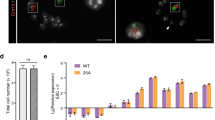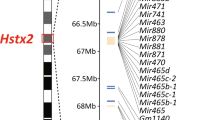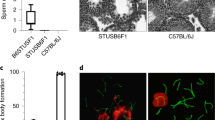Abstract
Interspecific hybridization between closely related species is commonly associated with decreased fertility or viability of F1 hybrids. Thus, in mouse interspecific hybrids, several different hybrid sterility genes that impair gametogenesis of the male hybrids have been described. We describe a novel effect in hybrids between different mouse species that manifests itself in abnormal growth of the placenta. Opposite phenotypes, that is, placental hypotrophy versus hypertrophy, are observed in reciprocal crosses and backcrosses. The severity of the phenotype, which is mainly caused by abnormal development of the spongiotrophoblast, is influenced by the sex of the conceptus. In general, placental hypertrophy is associated with increased fetal growth. Hypotrophy of the placenta frequently leads to growth impairment or death of the fetus. One of the major genetic determinants of placental growth maps to the proximal part of the mouse X chromosome.
This is a preview of subscription content, access via your institution
Access options
Subscribe to this journal
Receive 12 print issues and online access
$209.00 per year
only $17.42 per issue
Buy this article
- Purchase on Springer Link
- Instant access to full article PDF
Prices may be subject to local taxes which are calculated during checkout
Similar content being viewed by others
References
Coyne, J.A. Genetics and speciation. Nature 355, 511–515 (1992).
Wu, C. & Palopoli, M.F. Genetics of postmating reproductive isolation in animals. Annu. Rev. Genet. 27, 283–308 (1994).
Haldane, J.B.S. Sex-ratio and unisexual sterility in hybrid animals. J. Genet. 12, 101–109 (1922).
Britton, J., Pasteur, N. & Thaler, L. Les souris du Midi de la France: caractérisation génétique de deux groupes de populations sympatriques. C. R. Acad. Sci. Paris 283, 515–518 (1976).
Bonhomme, F. Evolutionary relationships in the genus Mus . in The Wild Mouse in Immunology (eds. Potter, M., Nadeau, J.H. & Cancro, M.P.) 19–34 (Springer-Verlag, Berlin, 1986).
Festetics, A. Ährenmaushügel in Österreich. Z. Säugetierkunde 26, 112–125 (1961).
Bonhomme, F., Catalan, J., Gerasimov, S., Orsini, P. & Thaler, L. Le complexe d'espèces du genre Mus en Europe Centrale et Orientale. I. Génétique. Z. Säugetierkunde. 48, 78–85 (1983).
Bonhomme, F., Martin, S. & Thaler, L. Hybridization between Mus musculus L and Mus spretus Lataste under laboratory conditions. Experientia 34, 1140–1141 (1978).
Guénet, J.-L., Nagamine, C., Simon-Chazottes, D., Montagutelli, X. & Bonhomme, F. Hst-3: an X-linked hybrid sterility gene. Genet. Res. Camb. 56, 163–165 (1990).
Biddle, F.G. Segregation distortion of X-linked marker genes in interspecific crosses between Mus musculus and Mus spretus . Genome 29, 389–392 (1987).
Eicher, E.M., Lee, B.K., Washburn, L.L., Hale, D.W. & King, T.R. Telomere-related markers for the pseudoautosomal region of the mouse genome. Proc. Natl. Acad. Sci. USA 89, 2160–2164 (1992).
Rowe, L.B. et al. Maps from two interspecific backcross DNA panels available as a community genetic mapping resource. Mam. Genome. 5, 253–274 (1994).
Lescisin, K.R., Varmuza, S. & Rossant, J. Isolation and characterization of a novel trophoblast-specific cDNA in the mouse. Genes Dev. 2, 1639–1646 (1989).
Rudert, F., Saunders, A.M., Rebstock, S., Thompson, J.A. & Zimmermann, W. Characterization of murine carcinoembryonic antigen gene family members. Mam. Genome. 3, 262–273 (1992).
Takagi, N. & Sasaki, M. Preferential inactivation of the paternally derived X chromosome in the extraembryonic membranes of the mouse. Nature 256, 640–642 (1975).
West, J.D., Frels, W.I., Chapman, V.M. & Papaioannou, V.E. Preferential expression of the maternally derived X chromosome in the mouse yolk sac. Cell 12, 873–882 (1977).
Sobis, H., Verstuyf, A. & Vandeputte, M. Histochemical differences inexpression of X-linked glucose-6-phosphate dehydrogenase between ectoderm- and endoderm-derived embryonic and extra-embryonic tissues. J. Histochem. Cytochem. 39, 569–574 (1991).
McLaren, A. Genetic and environmental effects on foetal and placental growth in mice. J. Reprod. Fert. 9, 79–98 (1965).
Lyon, M.F. Gene action in the X-chromosome of the mouse (Mus musculus). Nature 190, 372–373 (1961).
Nielsen, J.T. & Chapman, V.M. Electrophoretic variation for X-chromosome-linked phosphoglycerate kinase (PGK-1) in the mouse. Biochem. Genet. 21, 487–496 (1977).
Tan, S.S., Williams, E.A. & Tam, P.P.L. X-chromosome inactivation occurs at different times in different tissues of the post-implantation mouse embryo. Nature Genet. 3, 170–174 (1993).
Rogers, J.F. & Dawson, W.D. Foetal and placental size in a Peromyscus species cross. J. Reprod. Fert. 21, 255–262 (1970).
Catzeflis, F.M., Dickerman, A.W., Michaux, J. & Kirsch, J.A.W. DNA hybridization and rodent phylogeny. in Mammal Phytogeny: Vol.2: Placentals. (eds. Szalay, F.S., Novacek, M.J. & McKenna, M.C.) 159–172 (Springer-Verlag, Berlin, New York, 1993).
Allen, W.R., Skidmore, J.A., Stewart, F. & Antczak, D.F. Effects of fetal genotype and uterine environment on placental development in equids. J. Reprod. Fert. 97, 55–60 (1993).
Haig, D. Genetic conflicts in human pregnancy Quart. Rev. Biol. 68, 495–532 (1993).
Moore, T., Hurst, L.D. & Reik, W. Genetic conflict and evolution of mammalian X-chromosome inactivation. Dev. Genet. 17, 206–211 (1995).
Schmid, P., Schulz, W.A. & Hameister, H. Dynamic expression pattern of the myc protooncogene in midgestation mouse embryos. Science 243, 226–229 (1989).
Lyon, M.F. & Kirby, M.C. Mouse chromosome atlas. Mouse Genome 93, 23–66 (1995).
Dietrich, W.F. et al. A genetic map of the mouse with 4,006 simple sequence length polymorphisms. Nature Genet. 7, 220–245 (1994).
Copeland, N.G. et al. A genetic linkage map of the mouse: current applications and future prospects. Science 262, 57–66 (1993).
Supplemented by additional markers. in Whitehead Institute/MIT Center for Genome Research, Genetic Map of the Mouse, Database Release 9, February 7 (1995).
Saiki, R.K. et al. Primer-directed enzymatic amplification of DNA with a thermostable DNA polymerase. Science 239, 487–491 (1988).
Author information
Authors and Affiliations
Rights and permissions
About this article
Cite this article
Zechner, U., Reule, M., Orth, A. et al. An X-chromosome linked locus contributes to abnormal placental development in mouse interspecific hybrids. Nat Genet 12, 398–403 (1996). https://doi.org/10.1038/ng0496-398
Received:
Accepted:
Issue Date:
DOI: https://doi.org/10.1038/ng0496-398
This article is cited by
-
The uncharacterized gene 1700093K21Rik and flanking regions are correlated with reproductive isolation in the house mouse, Mus musculus
Mammalian Genome (2014)
-
Genetic and epigenetic incompatibilities underlie hybrid dysgenesis in Peromyscus
Nature Genetics (2000)
-
Global methylation in eutherian hybrids
Nature (1999)
-
Genomic imprinting is disrupted in interspecific Peromyscus hybrids
Nature Genetics (1998)
-
Non–mendelian inheritance of X chromosome markers in interspecific backcrosses
Nature Genetics (1996)



